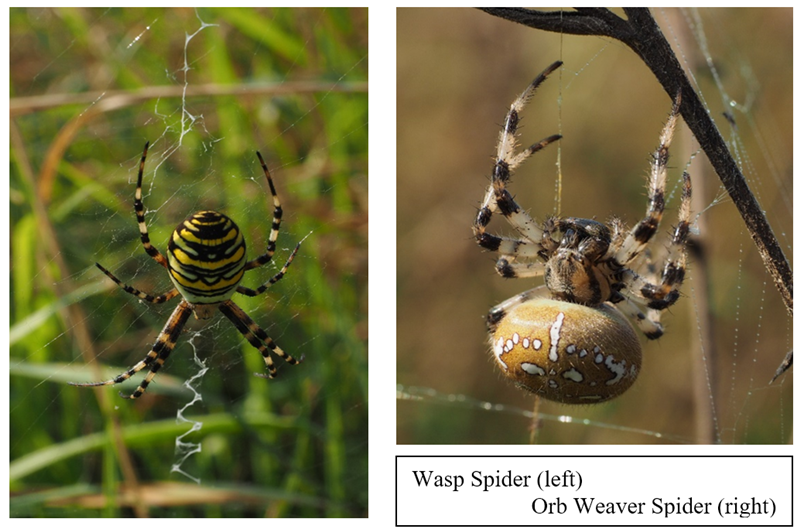Hinchingbrooke Country Park
Huntingdonshire Fauna & Flora Society, Mini Bioblitz July 2019
A mini-BioBlitz carried out by the Huntingdonshire Fauna and Flora Society on 10th July 2019 between 2.30 to 4.30pm provided an opportunity to assess the status of some elements of the flora and fauna of the Park. The plant species list for the Country Park is extensive. A total of 291 taxa have been recorded since 1989. In 2003 the HFFS report included a list of 189 of which 159 were rerecorded in 2019 (i.e. 30 were unrecorded). Most of the ‘missing’ species are common and likely to have been overlooked. In 2019 members of the Society recorded 260 taxa, including 101 ‘new’ records (i.e. not recorded in earlier surveys). Overall this result suggests that there has been a real increase in plant species diversity since 2003. The grassland and marginal vegetation around the lakes are considered in this note, but surveys were also undertaken of the woodland areas, including a fungus foray in October. These data will be augmented with records from the Cambridge and Peterborough Environmental Record Centre and personal records by HFFS Chair who has been visiting the site for more than 30 years. Further, more detailed analysis will be attempted in relation to the different vegetation management zones.
Three zones are noteworthy of special comment:
Zone P including the pond-dipping area. The pond has a good variety of Dragonflies and Damselflies including some of the following, recorded in 2018 from the whole of the CP by Mick Twinn:
| Azure Damselfly, Coenagrion puella; Banded Demoiselle, Calopteryx splendens; Blue-tailed Damselfly, Ischnura elegans; Common Blue Damselfly, Enallagma cyathigerum; Common Darter, Sympetrum striolatum; Emerald Damselfly, Lestes sponsa; Hairy Dragonfly, Brachytron pratense; |
|
Large Red Damselfly, Pyrrhosoma nymphula; Migrant Hawker, Aeshna mixta; Red-eyed Damselfly, Erythromma najas; Ruddy Darter, Sympetrum sanguineum; Scarce Chaser, Libellula fulva; Variable Damselfly, Coenagrion pulchellum; Willow Emerald Damselfly, Chalcolestes viridis; |
This grassland has a wealth of plants but is especially good for invertebrates. During the July survey the grassland area east of the pond was full of butterflies, the following noted by Pam Peacock and others:
| Meadow Brown, Maniola jurtina (33 Indivs); Small Skipper, Thymelicus sylvestris (8 indivs); Essex Skipper, Thymelicus lineola (3 indivs); Common Blue, Polyommatus icarus (2 indivs); Ringlet, Aphantopus hyperantus (2 indivs); |
Large Skipper, Ochlodes sylvanus (1 indiv); Marbled White, Melanargia galathea (1 indiv); Large white, Pieris brassicae (1 indiv); Comma, Polygonia c-album (1 indiv). |
The southern section of Zone Q, opposite the hide overlooking Lake Zone I included rough wet grassland plants such as Ragged-Robin. In 2019 colonies of two Orb Spiders: Wasp Spider Argiope bruennichi and Four-spotted Orb Weaver Araneus quadratus were found. The former a relatively recent colonist from the European continent, the latter our largest spider. The egg cocoons, often containing several hundred eggs, overwinter in the higher parts of the vegetation, hatching in the following spring. Cutting grassland, even during the autumn, winter or spring, adversely affects the survival of the spider.

Zone H lies almost entirely in Brampton Parish and was surveyed during 2013/14 as part of the Brampton Biodiversity Project. Although not included as one of the ‘Hot Spot’ reports at the time, more recent surveys suggest that it should have been. The zone includes examples of all the habitats present in the Park, with transitions between each. Alconbury Brook has several interesting species, including: Arrowhead, Sagittaria sagittifolia restricted to the main river systems and Water Horsetail, Equisetum fluviatile sparsely distributed in Huntingdonshire.
Zones M and N the woodland areas, including Bob’s Wood, were surveyed for Fungi on the 13th October (see HFFS News item). This produced one of the longest lists of fungi the Society has recorded. The list was compiled by Richard Shotbolt and included 104 unique taxa. The following note was prepared by Gordon Wyatt who found an individual of the Leptoglossus occidentalis during the survey.
“A Western Conifer Seed Bug was identified by Gordon Wyatt. The bug is a Nearctic leaf-footed pine bug which has recently arrived in the UK. It is a native of North America where it is a relatively serious pest in conifer seed nurseries particularly affecting Douglas fir (see HFFS News/Records).
It was first detected in Britain in 2007 found in Weymouth College, Dorset. Since then it has quickly spread around the south of England and up into the midlands, south Wales and west Yorkshire.
It was accidentally introduced to northern Italy in 1999 and has spread rapidly being recorded in Switzerland (2002); Spain and Slovenia (2003); Croatia and Hungary (2004); Austria (2005); Germany, France, Serbia and the Czech Republic (2006).
They feed on the flowers, cones and seeds of conifers including Scots pine and other pine trees, Douglas fir, spruce and cedar. The female can lay up to 80 eggs in May/June. The nymphs feed on the tender shoots and go through five stages of development before becoming an adult in late August.
The bug does not bite or sting and does not carry any known diseases.”
Copies of the report and detailed species list are available from This email address is being protected from spambots. You need JavaScript enabled to view it., Chair Huntingdonshire Fauna & Flora Society, who collated the data in 2019.


